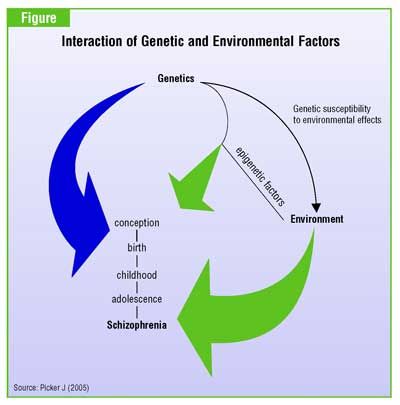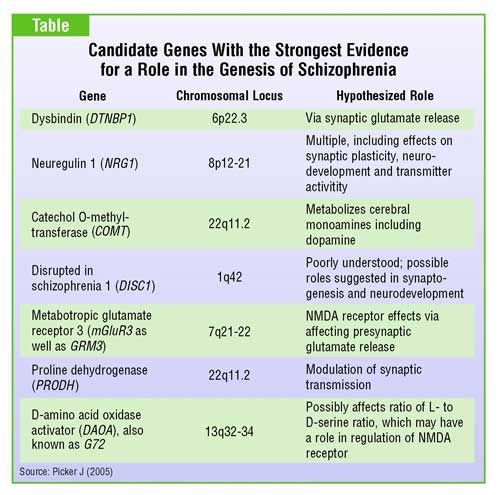Publication
Article
Psychiatric Times
The Role of Genetic and Environmental Factors in the Development of Schizophrenia
Author(s):
Recent research has shown environmental factors may increase the risk of schizophrenia in persons who may already have a genetic predisposition toward the illness.
Figure


Schizophrenia appears to be a disorder of development that results from a series of neurological insults from fetal life onward (Rapoport et al., 2005). Whether or not schizophrenia manifests appears to be the result of a conglomeration of these factors, both genetic and environmental in origin (Sullivan et al., 2003), as shown in the Figure.
No one factor appears to be most significant in the genesis of schizophrenia. This is evident despite the very significant resources that have been expended in the search to understand the patho-etiology of schizophrenia. This may be because there are multiple factors involved; multiple different disorders with varied pathologies present with the schizophrenia phenotype; or a combination of both. The search to uncover the pathological basis to schizophrenia has, however, provided broad generalizations that have yielded more specific etiological candidates as a result of newer, more powerful methodologies, particularly those resulting from the Human Genome Project. Interestingly, some of the genetic candidates identified providing explanatory models that may incorporate identified environmental risk factors.
Risk for schizophrenia appears to begin as early as the first trimester in pregnancy, with exposure to influenza associated with increased risk of later developing schizophrenia (Brown et al., 2004). Other prenatal factors are also implicated in the second and third trimesters. These include maternal rubella and respiratory infections, low socioeconomic class, maternal deprivation resulting from war or famine, urban birth, obstetric complications, and birth in late winter/early spring (Dohrenwend et al., 1992; Lewis and Murray, 1987; Marcelis et al., 1999; Susser et al., 1996; Torrey et al., 1997).
A direct observation of genetic and environmental factors interacting in the perinatal period was demonstrated when it was shown that fetal hypoxia, an environmental insult, was associated with decreased grey matter and increased cerebrospinal fluid (CSF) in patients with schizophrenia and their relatives but not in genetically low-risk individuals (Cannon et al., 1993).
Many of the prenatal factors listed are also associated with low folate, and it has also been suggested that some of these antenatal factors may exert at least a part of their effect through reducing maternal folate levels (Marzullo and Fraser, 2005). Low folate in turn may exert influence through elevation of plasma homocysteine (Doolin et al., 2002). The response of homocysteine to folate is, however, dependent upon the presence of specific genetic polymorphisms involved in homocysteine metabolism. The most notable of these polymorphisms is the folate-sensitive product of the 677C ->T methylenetetrahydrofolate gene variant, which participates in the remethylation of homocysteine to methionine. Presence of this gene variant results in elevated homocysteine in the presence of low folate (Murakami et al., 2001). This elevated homocysteine itself has modulatory effects at the N-methyl-D-aspartate (NMDA) receptor, the central element in the glutamatergic theory of schizophrenia (Kornhuber and Weller, 1997).
In addition, the 677C->T polymorphism has been found to be present at higher levels in patients with schizophrenia than the general population (Arinami et al., 1997; Regland et al., 1997). However, not all studies have been able to confirm this association (Virgos et al., 1999). The variability in findings is perhaps most notable for linkage studies that utilize population-wide gene frequencies, though evidence is becoming stronger for possible linkage for schizophrenia at chromosomal sites.
Two recent meta-analyses supported possible linkage at 1q, 2q, 3p, 5q, 6p, 8p, 11q, 13q, 14p, 20q and 22q, though they only agreed with respect to 8p and 22q (Badner and Gershon, 2002; Lewis et al., 2003), exemplifying the problems of linkage analysis for schizophrenia. Linkage studies have also not yet identified specific risk genes, though candidates such as neuregulin 1 (NRG1) and catechol O-methyltransferase (COMT) are present within the 8p and 22q candidate loci. It remains unclear, however, if this reflects a true association.
Family studies suggest that there may be many genetic loci involved in the genesis of schizophrenia and that no one gene is likely to confer greater than a threefold increased risk for schizophrenia (Risch, 1990). However, despite the relatively small effect of any one gene, there is a significant collective genetic risk for schizophrenia, with estimates of heritability as high as 80% (Cardno and Gottesman, 2000). Twin studies have provided the most significant evidence for a genetic component, with concordance between monozygotic twins in the range of 50%, even when raised from birth in different homes (Kendler et al., 1994; Tienari et al., 2004). This, however, leaves 50% discordance between monozygotic twins, which appears to be considerably more discordance than might be predicted from the calculated heritability of 80%.
Epigenetic influences, which alter gene expression through gene methylation, histone de-actylation and other regulatory mechanisms, may account for some of the difference. Evidence supporting the role of epigenetic effects is presented in a study that found increased methylation in a male without schizophrenia for the dopamine receptor gene DRD2, as compared to his discordant monozygotic twin brother with schizophrenia and another sibling with schizophrenia (Petronis et al., 2003).
Another possibility is that the difference between monozygotic twins reflects probabilistic, rather than mechanistic, outcomes. This hypothesis, reminiscent of quantum theory, suggests that as the number of risk genes increases, so too does the probability of developing schizophrenia, but there is no specific threshold that must be crossed before disease is expressed (Procopio, 2005).
With respect to actual risk genes for schizophrenia, numerous genes have been implicated but the evidence remains spartan. The strongest evidence currently available is for the genes dysbyndin and neuregulin 1 (NRG1) with somewhat less support available for COMT, DISC1, mGluR3, proline dehydrogenase (PRODH), G72, DAO and RGS4 (Harrison and Weinberger, 2005) (Table). The most likely candidates at this time include dysbyndin. This gene, found on chromosome 6p22.3, has widespread distribution throughout the brain. Reduced levels of dysbyndin protein and mRNA expression have been found in the dorsal prefrontal cortex of postmortem brains of patients with schizophrenia (Weickert et al., 2004). The function of this gene is speculative, but it has been suggested that it may be involved in synaptic glutamate release (Numakawa et al., 2004). However, despite studies showing an association, no mutation has yet been conclusively associated with schizophrenia.
Neuregulin 1 has also been associated with schizophrenia in several populations (Harrison and Weinberger, 2005) and appears to express multiple proteins with many functions relevant to neurodevelopment, plasticity and transmitter activity (Corfas et al., 2004). However, it remains unclear which are of relevance.
Catechol O-methyltransferase appears plausible because of mapping and deletion studies (particularly associated with velocardiofacial syndrome, which has a very high risk for psychotic disorders including schizophrenia) (Schosser and Aschauer, 2004). In addition, COMT is one of the two enzymes degrading catecholamines such as dopamine. Therefore, it plays a large role in cortical dopamine metabolism; dopamine being a central component of current theories of schizophrenia genesis (Keshavan, 1999). However, evidence regarding allelic variants and protein expression/activity differences in schizophrenia remain conflicting.
Indeed, this appears to be the case for other candidate genes (Craddock et al., 2005; Harrison and Weinberger, 2005). Their potential role as neurotransmitter modulators is biologically plausible because neurotransmitters, particularly dopamine, γ-aminobutyric acid (GABA) and glutamate, have all been strongly implicated in schizophrenia (Coyle, 2004; Kalkman and Loetscher, 2003).
Stress also influences glutamate and dopamine, providing an environmental factor that appears to modulate neurotransmitter function (Palomo et al., 2004). Furthermore, dopamine dysregulation may also arise through a process of sensitization. Some individuals are particularly sensitive to the effects of certain drugs for either genetic reasons or as a result of early environmental damage. Thus, stresses such as drug use and social adversity in adolescence or early adult life may propel the neurodevelopmentally impaired individual over a threshold (Howes et al., 2004). These postnatal factors are notable for having an ongoing genetic component and demonstrating that early genetic and environmental factors do not appear to be sufficient by themselves to result in schizophrenia.
It is clear that many genes and environmental factors may not have direct neurological relationships, such as in the case of celiac disease. This multifactorial gastrointestinal disorder results in increased gut permeability and has been hypothesized to result in ingress of psychomimetic compounds increasing the risk for schizophrenia (Wei and Hemmings, 2005). Thus, external environmental effectors may require a specific genetic background in order to gain systemic access, allowing them to exert either direct or indirect regulatory effects on gene expression relevant to schizophrenia.
In summary, various genetic components of schizophrenia are beginning to be identified. This has important implications for designing drugs that can act as environmental modulators and/or for identifying potentially preventive measures that can be undertaken. Although we are receiving glimmers as to these underlying mechanisms, these first clues provide real hope for preventive, ameliorative and potentially direct treatment options for schizophrenia.
Disclosures:
Dr. Picker directs the Metabolic Neurobehavioral Genetics Clinic at Children's Hospital Boston where he holds appointments in genetics and child psychiatry. He also has a research post at McLean Hospital.
References:
Arinami T, Yamada N, Yamakawa-Kobayashi K et al. (1997), Methylenetetrahydrofolate reductase variant and schizophrenia/depression. Am J Med Genet 74(5):526-528.
Badner JA, Gershon ES (2002), Meta-analysis of whole-genome linkage scans of bipolar disorder and schizophrenia. Mol Psychiatry 7(4):405-411.
Brown AS, Begg MD, Gravenstein S et al. (2004), Serologic evidence of prenatal influenza in the etiology of schizophrenia. Arch Gen Psychiatry 61(8):774-780.
Cannon TD, Mednick SA, Parnas J et al. (1993), Developmental brain abnormalities in the offspring of schizophrenic mothers. I. Contributions of genetic and perinatal factors. Arch Gen Psychiatry 50(7):551-564 [see comment].
Cardno AG, Gottesman II (2000), Twin studies of schizophrenia: from bow-and-arrow concordances to star wars Mx and functional genomics. Am J Med Genet 97(1):12-17.
Corfas G, Roy K, Buxbaum JD (2004), Neuregulin 1-erbB signaling and the molecular/cellular basis of schizophrenia. Nat Neurosci 7(6):575-580.
Coyle JT (2004), The GABA-glutamate connection in schizophrenia: which is the proximate cause? Biochem Pharmacol 68(8):1507-1514.
Craddock N, O'Donovan MC, Owen MJ (2005), The genetics of schizophrenia and bipolar disorder: dissecting psychosis. J Med Genet 42(3):193-204.
Dohrenwend BP, Levav I, Shrout PE et al. (1992), Socioeconomic status and psychiatric disorders: the causation-selection issue. Science 255(5047):946-952.
Doolin MT, Barbaux S, McDonnell M et al. (2002), Maternal genetic effects, exerted by genes involved in homocysteine remethylation, influence the risk of spina bifida. Am J Hum Genet 71(5):1222-1226.
Harrison PJ, Weinberger DR (2005), Schizophrenia genes, gene expression, and neuropathology: on the matter of their convergence. [Published erratum Mol Psychiatry 10(4):420.] Mol Psychiatry 10(1):40-68.
Howes OD, McDonald C, Cannon M et al. (2004), Pathways to schizophrenia: the impact of environmental factors. Int J Neuropsychopharmacol 7(suppl 1):S7-S13.
Kalkman HO, Loetscher E (2003), GAD(67): the link between the GABA-deficit hypothesis and the dopaminergic- and glutamatergic theories of psychosis. J Neural Transm 110(7):803-812.
Kendler KS, Gruenberg AM, Kinney DK (1994), Independent diagnoses of adoptees and relatives as defined by DSM-III in the provincial and national samples of the Danish Adoption Study of Schizophrenia. Arch Gen Psychiatry 51(6):456-468.
Keshavan MS (1999), Development, disease and degeneration in schizophrenia: a unitary pathophysiological model. J Psychiatr Res 33(6):513-521.
Kornhuber J, Weller M (1997), Psychotogenicity and N-methyl-D-aspartate receptor antagonism: implications for neuroprotective pharmacotherapy. Biol Psychiatry 41(2):135-144.
Lewis CM, Levinson DF, Wise LH et al. (2003), Genome scan meta-analysis of schizophrenia and bipolar disorder, part II: schizophrenia. Am J Hum Genet 73(1):34-48.
Lewis SW, Murray RM (1987), Obstetric complications, neurodevelopmental deviance, and the risk of schizophrenia. J Psychiatr Res 21(4):413-421.
Marcelis M, Takei N, van Os J (1999), Urbanization and risk for schizophrenia: does the effect operate before or around the time of illness onset? Psychol Med 29(5):1197-1203.
Marzullo G, Fraser FC (2005), Similar rhythms of seasonal conceptions in neural tube defects and schizophrenia: a hypothesis of oxidant stress and the photoperiod. Birth Defects Res A Clin Mol Teratol 73(1):1-5.
Murakami S, Matsubara N, Saitoh M et al. (2001), The relation between plasma homocysteine concentration and methylenetetrahydrofolate reductase gene polymorphism in pregnant women. J Obstet Gynaecol Res 27(6):349-352.
Numakawa T, Yagasaki Y, Ishimoto T et al. (2004), Evidence of novel neuronal functions of dysbindin, a susceptibility gene for schizophrenia. Hum Mol Genet 13(21):2699-2708.
Palomo T, Archer T, Kostrzewa RM, Beninger RJ (2004), Gene-environment interplay in schizopsychotic disorders. Neurotox Res 6(1):1-9.
Petronis A, Gottesman II, Kan P et al. (2003), Monozygotic twins exhibit numerous epigenetic differences: clues to twin discordance? Schizophr Bull 29(1):169-178.
Procopio M (2005), Does god play dice with schizophrenia? A probabilistic model for the understanding of causation in mental illness. Med Hypotheses 64(4):872-877.
Rapoport JL, Addington AM, Frangou S (2005), The neurodevelopmental model of schizophrenia: update 2005. Mol Psychiatry 10(6):614.
Regland B, Germgard T, Gottfries CG et al. (1997), Homozygous thermolabile methylenetetrahydrofolate reductase in schizophrenia-like psychosis. J Neural Transm 104(8-9):931-941.
Risch N (1990), Genetic linkage and complex diseases, with special reference to psychiatric disorders. Genet Epidemiol 7(1):3-16; discussion 17-45.
Schosser A, Aschauer HN (2004), [In search of susceptibility genes for schizophrenia.] Wien Klin Wochenschr 116(24):827-833.
Sullivan PF, Kendler KS, Neale MC (2003), Schizophrenia as a complex trait: evidence from a meta-analysis of twin studies. Arch Gen Psychiatry 60(12):1187-1192.
Susser E, Neugebauer R, Hoek HW et al. (1996), Schizophrenia after prenatal famine. Further evidence. Arch Gen Psychiatry 53(1):25-31 [see comment].
Tienari P, Wynne LC, Sorri A et al. (2004), Genotype-environment interaction in schizophrenia-spectrum disorder. Long-term follow-up study of Finnish adoptees. Br J Psychiatry 184:216-222.
Torrey EF, Miller J, Rawlings R, Yolken RH (1997), Seasonality of births in schizophrenia and bipolar disorder: a review of the literature. Schizophr Res 28(1):1-38.
Virgos C, Martorell L, Simo JM et al. (1999), Plasma homocysteine and the methylenetetrahydrofolate reductase C677T gene variant: lack of association with schizophrenia. Neuroreport 10(10):2035-2038.
Wei J, Hemmings GP (2005), Gene, gut and schizophrenia: the meeting point for the gene-environment interaction in developing schizophrenia. Med Hypotheses 64(3):547-552.
Weickert CS, Straub RE, McClintock BW et al. (2004), Human dysbindin (DTNBP1) gene expression in normal brain and in schizophrenic prefrontal cortex and midbrain. Arch Gen Psychiatry 61(6):544-555.






